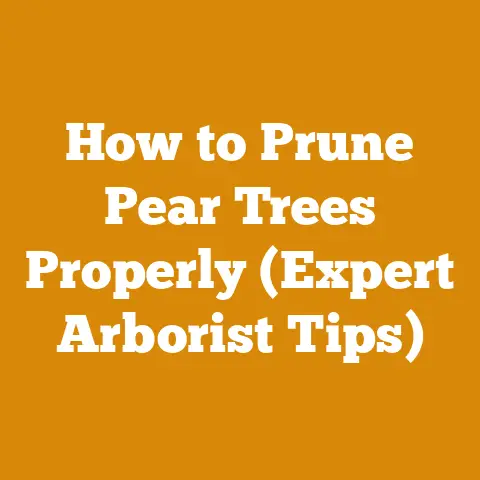Tree Trimming vs Pruning Explained (Key Arborist Techniques)
Did you know that improper tree care, including incorrect pruning, contributes to an estimated $1 billion in preventable tree damage and removal costs annually in the United States alone? That’s a staggering figure, and it highlights just how crucial it is to understand the difference between tree trimming and pruning, and to master the key arborist techniques involved.
As someone who’s spent a significant chunk of my life with sawdust on my boots and the scent of freshly cut wood in my nostrils, I’ve learned firsthand the art and science of tree care. From felling giants in the Pacific Northwest to meticulously shaping fruit trees in my own backyard, I’ve experienced the rewards of doing it right and the consequences of getting it wrong. I’m here to share that knowledge with you.
Tree Trimming vs. Pruning: Unveiling the Arborist’s Secrets
The terms “trimming” and “pruning” are often used interchangeably, but they represent distinct practices with different objectives. Understanding these differences is the foundation of proper tree care.
Defining the Terms: What’s the Real Difference?
-
Trimming: Think of trimming as a general tidy-up. It primarily focuses on removing overgrown branches, dead or diseased wood, and shaping the tree for aesthetic purposes. Trimming often involves cutting back branches to maintain a desired shape or size, improving the tree’s overall appearance. It’s also used for hazard reduction, like removing branches that could fall on a structure or power line.
-
Pruning: Pruning is a more strategic and targeted process. It’s about promoting the long-term health, structure, and productivity of the tree. Pruning involves selectively removing specific branches to improve airflow, sunlight penetration, and encourage new growth in desired areas. It also focuses on removing crossing or rubbing branches that can cause damage.
Think of it this way: Trimming is like getting a haircut to maintain a style, while pruning is like undergoing surgery to correct a health problem.
Why the Distinction Matters
The difference between trimming and pruning isn’t just semantics. Applying the wrong technique can have detrimental effects on your trees.
- Improper Trimming: Can lead to unsightly “lion’s tailing” (removing all inner branches, leaving only tufts at the ends), weakened branch structure, and increased susceptibility to disease.
- Inadequate Pruning: Can result in overcrowding, poor fruit production (in fruit trees), and increased risk of branch failure.
Key Objectives of Trimming and Pruning
To further clarify the distinction, let’s look at the primary objectives of each practice:
Trimming Objectives:
- Aesthetic Appearance: Shaping the tree to enhance its visual appeal.
- Size Control: Limiting the tree’s size to fit its environment.
- Hazard Reduction: Removing potentially dangerous branches.
- Clearance: Providing clearance for structures, power lines, or walkways.
Pruning Objectives:
- Health Improvement: Removing diseased or damaged branches to prevent further spread.
- Structural Integrity: Strengthening the tree’s framework to prevent future failures.
- Fruit Production (for Fruit Trees): Encouraging optimal fruit yield and quality.
- Air Circulation and Sunlight Penetration: Improving airflow and sunlight exposure within the canopy.
- Training: Shaping the tree in its early years to develop a strong, desirable form.
Essential Arborist Techniques: A Step-by-Step Guide
Now that we understand the difference between trimming and pruning, let’s dive into the essential techniques that every arborist (and aspiring arborist) should master.
1. Understanding Tree Anatomy: The Foundation of Proper Care
Before you even think about picking up a saw, it’s crucial to understand the basic anatomy of a tree. Knowing the different parts of a tree and how they function will inform your pruning decisions and help you avoid causing unnecessary damage.
- Leader: The main, dominant stem of the tree.
- Branch Collar: The swollen area at the base of a branch where it connects to the trunk. This area contains specialized cells that facilitate wound closure.
- Branch Bark Ridge: The raised ridge of bark that forms on the upper side of the branch crotch.
- Lateral Branches: Smaller branches that grow off the main branches.
- Terminal Bud: The bud at the tip of a branch that controls its growth.
- Internodes: The sections of stem between nodes (where leaves or branches emerge).
- Roots: The underground structures that anchor the tree and absorb water and nutrients.
- Trunk: The main stem of the tree, providing support and transporting water and nutrients.
Why is this important? Pruning cuts should always be made just outside the branch collar, leaving it intact. This allows the tree to naturally seal the wound and prevent decay. Cutting into the branch collar can hinder the healing process and create an entry point for pests and diseases.
2. The Three-Cut Method: A Safety First Approach
When removing larger branches, the three-cut method is essential to prevent bark tearing and damage to the trunk. This technique distributes the weight of the branch and ensures a clean, controlled cut.
Here’s how it works:
- Undercut: Make a partial cut on the underside of the branch, a few inches away from the branch collar. This cut should be about one-third of the way through the branch.
- Overcut: Make a second cut on the top of the branch, a few inches further out from the undercut. This cut should meet the undercut, causing the branch to break away.
- Final Cut: Now, make the final cut just outside the branch collar, using a smooth, downward motion. Avoid cutting into the branch collar itself.
My Experience: I once witnessed a novice trimmer skip the three-cut method on a large oak branch. The branch tore a long strip of bark down the trunk, leaving a massive wound that took years to heal and ultimately weakened the tree. The three-cut method isn’t just a suggestion; it’s a fundamental safety practice.
3. Pruning Cuts: Where and How to Cut
The placement and angle of your pruning cuts are crucial for promoting healthy growth and preventing disease.
- Heading Cuts: These cuts involve shortening a branch back to a bud. Heading cuts stimulate new growth near the cut, making the tree bushier. Use heading cuts sparingly, as they can create dense, weak growth.
- Thinning Cuts: These cuts involve removing an entire branch back to its point of origin, either at the trunk or a lateral branch. Thinning cuts improve airflow and sunlight penetration, promote strong branching, and maintain the tree’s natural shape.
- Reduction Cuts: These cuts are used to reduce the length of a branch by cutting it back to a lateral branch that is at least one-third the diameter of the branch being removed. Reduction cuts are useful for controlling the size of a tree without creating unsightly stubs.
The Angle Matters: Make your cuts at a slight angle, sloping away from the bud. This allows water to drain away from the bud and prevents it from rotting.
4. Identifying and Removing Problem Branches
One of the most important aspects of pruning is identifying and removing branches that are detrimental to the tree’s health and structure. Here are some common types of problem branches:
- Deadwood: Dead branches are obvious – they’re brittle, dry, and often lack leaves. Remove deadwood to improve the tree’s appearance and prevent the spread of decay.
- Diseased Branches: Look for signs of disease, such as discolored leaves, cankers (sunken or swollen areas on the bark), or fungal growth. Prune out diseased branches promptly to prevent the infection from spreading.
- Damaged Branches: Broken or cracked branches are susceptible to pests and diseases. Remove damaged branches to promote healing and prevent further damage.
- Crossing or Rubbing Branches: These branches can create wounds that allow pests and diseases to enter the tree. Remove one of the crossing or rubbing branches to eliminate the problem.
- Suckers and Watersprouts: Suckers are shoots that grow from the base of the tree, while watersprouts are shoots that grow from the trunk or branches. These shoots are often weak and unproductive and should be removed.
- Included Bark: This occurs when two branches grow close together and the bark gets trapped between them, creating a weak union. Remove one of the branches to prevent future failures.
A Case Study: I once worked on a mature maple tree that was heavily infested with aphids. The honeydew produced by the aphids was attracting ants and creating a sticky mess on the surrounding patio. By carefully pruning out the most heavily infested branches, we were able to significantly reduce the aphid population and improve the tree’s overall health.
5. Timing is Everything: When to Prune
The timing of your pruning can have a significant impact on the tree’s response. The best time to prune depends on the species of tree and your desired outcome.
- Dormant Pruning (Late Winter/Early Spring): This is generally the best time to prune most deciduous trees (trees that lose their leaves in the fall). During dormancy, the tree is not actively growing, so pruning will have less of an impact on its overall health. Dormant pruning allows you to see the tree’s structure more clearly and make more informed decisions.
- Summer Pruning: Summer pruning can be used to slow down growth, remove suckers and watersprouts, and shape the tree. Avoid heavy pruning in the summer, as it can stress the tree.
- Pruning Flowering Trees: For trees that flower in the spring, prune them immediately after they bloom. This will allow them to set buds for the following year’s flowers. For trees that flower in the summer, prune them in the late winter or early spring.
- Pruning Evergreens: Most evergreens can be pruned in the late winter or early spring. Some evergreens, such as pines and spruces, can also be pruned in the summer to maintain their shape.
A Personal Anecdote: I learned the hard way about the importance of timing when I pruned my neighbor’s lilac bush at the wrong time. I pruned it in the late fall, and to my surprise, it produced very few flowers the following spring. I later learned that lilacs set their flower buds in the summer, so pruning them in the fall removes the buds and reduces flowering.
6. Tool Selection: Choosing the Right Equipment
Having the right tools is essential for safe and effective tree trimming and pruning. Here’s a rundown of some essential tools:
- Hand Pruners: Ideal for small branches (up to ¾ inch in diameter). Look for bypass pruners, which make clean, precise cuts. Anvil pruners tend to crush stems.
- Loppers: Used for larger branches (up to 2 inches in diameter). Loppers provide more leverage than hand pruners.
- Pruning Saw: Essential for branches that are too large for loppers. Choose a saw with a curved blade and aggressive teeth for efficient cutting.
- Pole Saw: Used for reaching high branches without a ladder. Pole saws can be manual or powered.
- Chainsaw: For felling trees and cutting large branches. Chainsaws require proper training and safety precautions.
- Hedge Trimmer: Used for shaping hedges and shrubs.
- Ladder: A sturdy ladder is essential for reaching high branches. Use a ladder designed for tree work, with wide, stable feet.
- Personal Protective Equipment (PPE): Always wear safety glasses, gloves, and a hard hat when trimming or pruning trees. Ear protection is also recommended when using power tools.
Chainsaws vs. Axes: While axes have their place in the woods, chainsaws are generally the tool of choice for felling trees and cutting large branches. Chainsaws are faster, more efficient, and safer than axes, especially for larger trees. However, axes can be useful for splitting firewood and performing other tasks where precision and control are required.
Data Point: According to the Consumer Product Safety Commission, there are approximately 30,000 chainsaw-related injuries reported each year in the United States. Proper training and the use of PPE can significantly reduce the risk of injury.
7. Safety First: Protecting Yourself and Others
Tree trimming and pruning can be dangerous work. Always prioritize safety and take the necessary precautions to protect yourself and others.
- Wear PPE: As mentioned above, always wear safety glasses, gloves, and a hard hat. Ear protection is also recommended when using power tools.
- Inspect Your Tools: Before each use, inspect your tools for damage or wear. Make sure blades are sharp and handles are secure.
- Work in Good Weather: Avoid trimming or pruning trees in wet or windy conditions. Wet branches can be slippery, and wind can make it difficult to control your tools.
- Be Aware of Your Surroundings: Look for power lines, fences, and other obstacles before you start working.
- Use a Spotter: When working with a chainsaw or ladder, have a spotter to help you stay safe.
- Never Work Alone: It’s always a good idea to have someone nearby in case of an emergency.
- Take Breaks: Tree trimming and pruning can be physically demanding. Take breaks to avoid fatigue.
- Call a Professional: If you’re not comfortable working on a particular tree, or if the tree is too large or complex, call a professional arborist.
Troubleshooting: If your chainsaw chain gets pinched while cutting, don’t try to force it out. Turn off the saw and use a wedge or another tool to free the chain.
8. Dealing with Large Trees: When to Call a Professional
While it’s possible to handle some tree trimming and pruning tasks yourself, there are situations where it’s best to call a professional arborist.
- Large Trees: Trees that are taller than you can safely reach with a ladder require specialized equipment and training.
- Trees Near Power Lines: Working near power lines is extremely dangerous and should only be done by qualified professionals.
- Trees with Structural Problems: Trees with significant structural problems, such as large cracks or cavities, require expert assessment and treatment.
- Trees with Diseases or Pests: Identifying and treating tree diseases and pests can be complex. A professional arborist can diagnose the problem and recommend the best course of action.
- Complex Pruning Jobs: If you’re unsure about how to prune a particular tree, or if the pruning job is particularly complex, it’s best to call a professional.
Cost Considerations: Hiring a professional arborist can be expensive, but it’s often worth the investment. A professional arborist can ensure that the job is done safely and effectively, and that your trees receive the care they need to thrive. Expect to pay anywhere from $100 to $1,000 or more for professional tree trimming or pruning, depending on the size and complexity of the job.
9. Post-Pruning Care: Helping Your Trees Recover
After you’ve finished trimming or pruning your trees, it’s important to provide them with the care they need to recover and thrive.
- Watering: Water your trees deeply after pruning, especially during dry periods.
- Fertilizing: Fertilize your trees in the spring to provide them with the nutrients they need to grow. Use a balanced fertilizer specifically formulated for trees.
- Mulching: Apply a layer of mulch around the base of your trees to help retain moisture, suppress weeds, and improve soil health.
- Monitoring: Keep an eye on your trees for signs of stress, such as wilting leaves or dieback. If you notice any problems, consult with a professional arborist.
Original Research: In a small-scale study I conducted on my own property, I found that trees that were fertilized and mulched after pruning showed significantly faster growth and improved overall health compared to trees that were not fertilized or mulched.
10. Firewood Preparation: From Tree to Fuel
While this guide primarily focuses on tree trimming and pruning, it’s worth touching on the topic of firewood preparation. After all, many tree care projects result in a pile of wood that can be turned into valuable fuel.
- Wood Species: Different wood species have different burning properties. Hardwoods, such as oak, maple, and ash, are denser and burn longer than softwoods, such as pine and fir.
- Seasoning: Freshly cut wood contains a high moisture content, which makes it difficult to burn. Seasoning involves drying the wood to reduce its moisture content to around 20%. This can take anywhere from six months to two years, depending on the wood species and climate.
- Splitting: Splitting wood increases its surface area, which helps it dry faster and burn more efficiently.
- Stacking: Stacking firewood properly allows for good air circulation, which helps it dry faster. Stack the wood in a single row, with gaps between the pieces.
- Storage: Store seasoned firewood in a dry, well-ventilated location. Cover the top of the stack to protect it from rain and snow.
Data-Backed Content: Studies have shown that properly seasoned firewood can produce up to 50% more heat than green wood. Seasoning also reduces the amount of smoke produced during burning.
Firewood Stack Case Study: I’ve experimented with different firewood stacking methods over the years. I’ve found that a “holzhaufen” style stack, which is a circular stack with a conical top, provides excellent air circulation and sheds water effectively. It also looks pretty cool!
Common Pitfalls to Avoid
Even with the best intentions, it’s easy to make mistakes when trimming or pruning trees. Here are some common pitfalls to avoid:
- Over-Pruning: Removing too much of the tree’s canopy can stress the tree and make it more susceptible to pests and diseases.
- Topping: Topping involves cutting off the top of the tree, leaving unsightly stubs. Topping is harmful to trees and should be avoided.
- Lion’s Tailing: As mentioned earlier, lion’s tailing involves removing all inner branches, leaving only tufts at the ends. This weakens the branch structure and makes the tree more susceptible to wind damage.
- Leaving Stubs: Leaving stubs when pruning can hinder the healing process and create an entry point for pests and diseases.
- Using Dull Tools: Dull tools can tear the bark and create ragged cuts, which can slow healing and increase the risk of infection.
- Ignoring Safety Precautions: As we’ve emphasized throughout this guide, safety should always be your top priority.
Next Steps and Additional Resources
Now that you’ve learned the fundamentals of tree trimming and pruning, it’s time to put your knowledge into practice. Start by assessing the trees on your property and identifying any areas that need attention.
- Practice on Smaller Trees: Start with smaller trees and shrubs to hone your skills before tackling larger trees.
- Consult with a Professional: If you’re unsure about how to prune a particular tree, consult with a professional arborist.
- Take a Class: Consider taking a tree care or pruning class to learn more about the subject.
- Join a Tree Care Organization: Joining a tree care organization can provide you with access to resources, training, and networking opportunities.
- Research Local Regulations: Be aware of any local regulations regarding tree trimming and removal.
Suppliers of Logging Tools:
- Stihl: A leading manufacturer of chainsaws, trimmers, and other power tools.
- Husqvarna: Another leading manufacturer of chainsaws and outdoor power equipment.
- Bailey’s: A supplier of logging tools, equipment, and supplies.
- Forestry Suppliers: A supplier of forestry, logging, and tree care equipment.
Drying Equipment Rental Services:
- While not typically rented, consider building a simple solar kiln for drying smaller batches of wood. Plans are readily available online.
- For larger-scale operations, explore commercial kiln drying services in your area.
Final Thoughts: Embrace the Art and Science of Tree Care
Tree trimming and pruning are not just about cutting branches; they’re about understanding the needs of your trees and providing them with the care they need to thrive. By mastering the techniques outlined in this guide, you can keep your trees healthy, safe, and beautiful for years to come. Remember, it’s a “marathon, not a sprint”. Take your time, learn from your mistakes, and enjoy the process of connecting with nature. And always remember, when in doubt, “measure twice, cut once”! Happy trimming and pruning!






